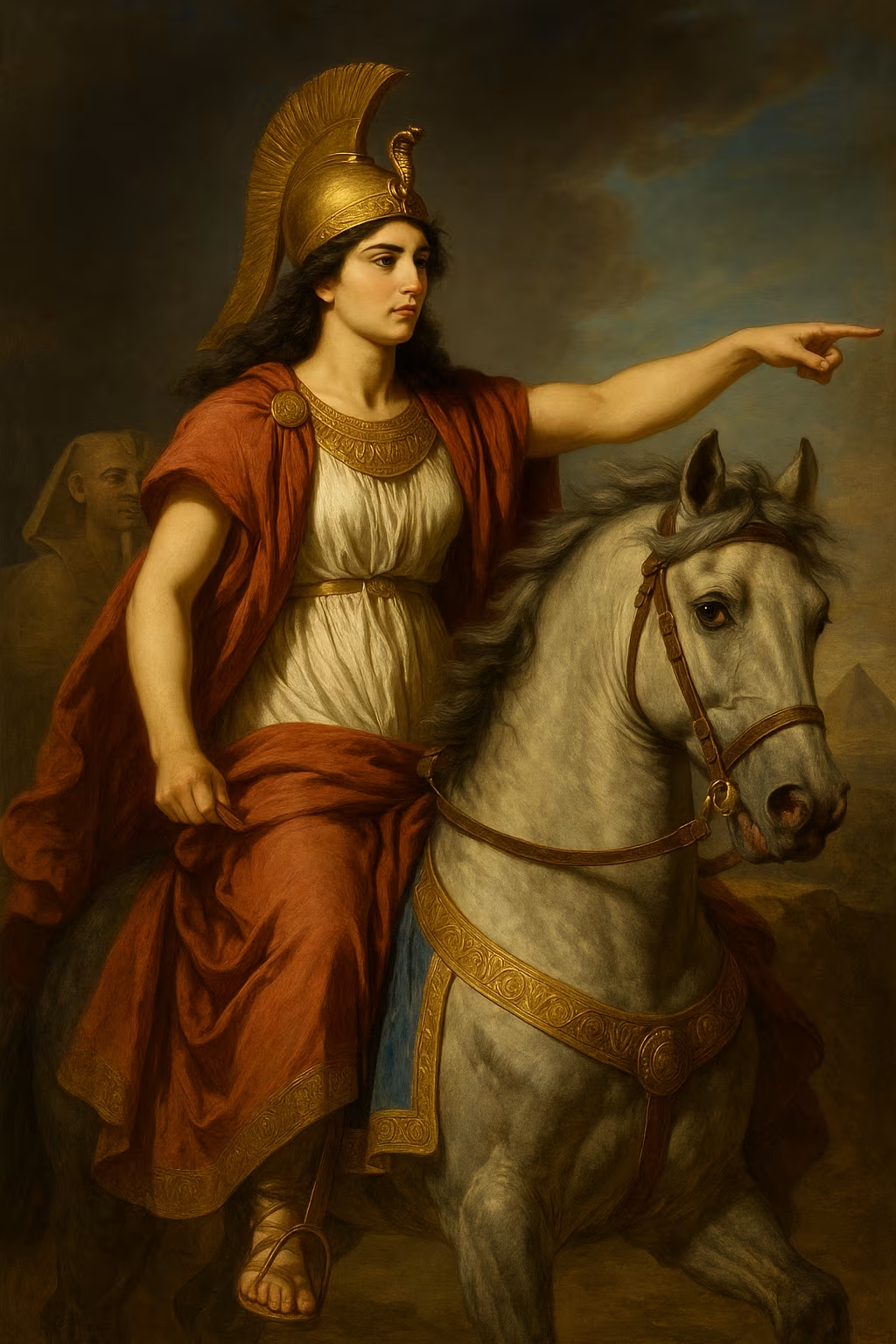Cleopatra VII Philopator (69 BC – 30 BC)
Quick Summary
Cleopatra VII Philopator (69 BC – 30 BC) was a queen of egypt and major figure in history. Born in Alexandria, Ptolemaic Egypt, Cleopatra VII Philopator left a lasting impact through Preserved Egyptian autonomy for two decades amid Roman civil wars.

Birth
69 BC Alexandria, Ptolemaic Egypt
Death
August 12, 30 BC Alexandria, Ptolemaic Egypt
Nationality
Egyptian (Macedonian dynasty)
Occupations
Complete Biography
Early Life
Cleopatra VII was born in 69 BC in Alexandria, the intellectual and economic capital of the Ptolemaic kingdom. Daughter of Ptolemy XII Auletes and probably Cleopatra V Tryphaena, she belonged to the Greek-Macedonian dynasty founded by Ptolemy I, one of Alexander the Great’s generals. Unlike most of her predecessors, who often remained aloof from native traditions, Cleopatra embraced Egyptian culture and became the first Ptolemaic monarch known to speak Egyptian. Ancient sources suggest she mastered several languages, including Greek, Aramaic, Syriac, Ethiopian, Hebrew, and Latin. Trained in the Greek paideia, she studied rhetoric, philosophy, astronomy, mathematics, and medicine, giving her a reputation as a learned ruler. The Alexandria of her youth, with its Library and Mouseion, was a cosmopolitan hub of scholarship, trade, and diplomacy, providing her with an environment that honed her political and intellectual skills.
Dynastic Context And Accession
Upon the death of Ptolemy XII in 51 BC, Cleopatra, aged about eighteen, ascended the throne as co-ruler with her younger brother Ptolemy XIII, whom she married according to dynastic custom. Court intrigues and the influence of her brother’s regents soon marginalized her, forcing her into exile in 49 BC. From Syria and Cyrenaica, she gathered troops to reclaim her throne, demonstrating early her ability to combine diplomacy, propaganda, and military force.
Alliance With Julius Caesar
In 48 BC, as Julius Caesar pursued Pompey into Egypt, Cleopatra secured a dramatic audience with the Roman general—famously rolled into Caesar’s chambers in a rug, according to Plutarch. Caesar took her side against Ptolemy XIII, sparking the Alexandrian War (48–47 BC). After months of fierce fighting and the partial destruction of the Library of Alexandria, Caesar’s victory restored Cleopatra to the throne alongside her younger brother Ptolemy XIV. In 47 BC, she bore Caesar a son, Ptolemy XV Caesarion. She later visited Rome (46–44 BC), where her presence caused both admiration and scandal. Following Caesar’s assassination in 44 BC, she returned to Egypt.
Rule And Statecraft
Cleopatra proved to be a pragmatic and reforming monarch. She reorganized taxation, bolstered state revenues through grain exports and papyrus trade, and issued coinage bearing her portrait to assert sovereignty. Through powerful propaganda, she presented herself as the living incarnation of Isis, blending Greek and Egyptian traditions. Rituals, dynastic cults, and public ceremonies reinforced her authority. She carefully balanced the support of Alexandria’s Greek elite with that of the Egyptian priesthood and local communities, consolidating a dual legitimacy. Alexandria flourished under her patronage as both an economic powerhouse and a center of Mediterranean diplomacy and scholarship.
Relationship With Mark Antony
After Caesar’s death and the division of power between Octavian and Mark Antony, Cleopatra forged a new political alliance. Meeting Antony at Tarsus in 41 BC, she provided him with ships, funds, and strategic bases in exchange for recognition of her rule and territorial concessions in Syria, Phoenicia, and Cilicia. Their partnership, both political and romantic, produced three children: twins Alexander Helios and Cleopatra Selene, and Ptolemy Philadelphus. Together they envisioned an eastern hegemony capable of rivaling Octavian’s Rome.
Propaganda And War With Octavian
Octavian exploited the Antony-Cleopatra alliance in a propaganda campaign portraying Cleopatra as an eastern temptress corrupting a Roman statesman. By 32 BC, tensions escalated into open war. In 31 BC, at the Battle of Actium, Octavian’s admiral Agrippa decisively outmaneuvered Antony and Cleopatra’s fleet. Their retreat to Egypt marked the collapse of their eastern project.
Downfall And Death
In 30 BC, Octavian invaded Egypt. Antony, believing Cleopatra dead, took his own life. Cleopatra, refusing the humiliation of being paraded in a Roman triumph, chose suicide—traditionally by the bite of an asp, though historians debate the likelihood of poison. Caesarion, her son by Caesar, was executed on Octavian’s orders. Egypt was annexed as the personal province of Augustus, securing Rome a vital source of grain and wealth.
Legacy And Reception
Cleopatra’s image was shaped by Augustan propaganda and later by Plutarch and Dio Cassius, who emphasized her seduction and extravagance. Renaissance and Baroque art reimagined her as a symbol of tragic beauty, while Romanticism emphasized her fate as a doomed heroine. In modern times, Shakespeare and cinema (notably the 1963 film 'Cleopatra' starring Elizabeth Taylor) further entrenched her myth. Beyond legend, historians highlight her as a shrewd diplomat, accomplished linguist, and naval strategist, and one of the most remarkable female rulers of antiquity.
Achievements and Legacy
Major Achievements
- Preserved Egyptian autonomy for two decades amid Roman civil wars
- Reasserted the Ptolemaic throne through alliance with Julius Caesar
- Forged an eastern bloc with Mark Antony to counter Octavian
- Advanced a Greco-Egyptian royal ideology (Isis imagery, dynastic cult)
- Projected soft power via Alexandria’s scholarship and economy
Historical Legacy
Cleopatra stands at the hinge of Hellenistic and Roman worlds. Stripped of myth, she emerges as a pragmatic ruler negotiating survival through diplomacy, finance, and naval power—an enduring emblem of female sovereignty and Mediterranean statecraft.
Detailed Timeline
Major Events
Birth
69 BC, Alexandria
Accession
Co-ruler with Ptolemy XIII after Ptolemy XII’s death
Alliance with Caesar
Alexandrian War; restoration to the throne
Caesarion
Birth of Ptolemy XV Caesarion
Tarsus Meeting
Alliance with Mark Antony
Actium
Defeat by Octavian’s forces
Death
Suicide in Alexandria; Egypt annexed by Rome
Geographic Timeline
Famous Quotes
"I will not be triumphed over."
"My honor was not yielded; it was preserved."
External Links
Frequently Asked Questions
When was Cleopatra born and when did she die?
Born 69 BC in Alexandria; died August 30 BC in Alexandria.
Who were Cleopatra’s key Roman allies?
Julius Caesar and Mark Antony.
How did Cleopatra die?
Ancient sources report an asp bite; many historians consider poison likely.
Who was Caesarion?
Ptolemy XV Caesarion, Cleopatra’s son with Julius Caesar; executed by Octavian after 30 BC.
Why is Cleopatra significant?
She was the last independent monarch of Egypt, an accomplished diplomat, and a symbol of female political power.
Sources and Bibliography
Primary Sources
- Plutarque, Vie d’Antoine
- Dion Cassius, Histoire romaine
Secondary Sources
- Roller D. W., Cleopatra: A Biography ISBN: 9780195365535
- Ashton S.-A., Cleopatra and Egypt ISBN: 9781405113942
External References
See Also
Related Figures
Specialized Sites
Batailles de France
Discover battles related to this figure
Dynasties Legacy
Coming soonExplore royal and noble lineages
Timeline France
Coming soonVisualize events on the chronological timeline
